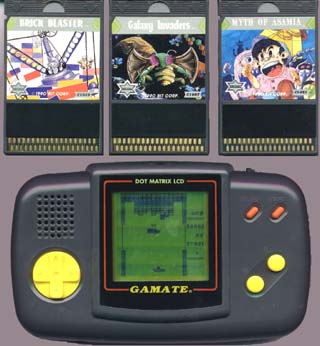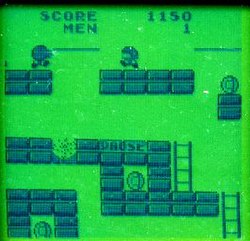Gamate
Handheld game console From Wikipedia, the free encyclopedia
The Gamate,[2] known as 超級小子 (pinyin: chāojí xiǎozi, literally "Super Boy") in Taiwan and 超级神童 (pinyin: chāojí shéntóng, literally "Super Child Prodigy") in China, is a handheld game console manufactured by Bit Corporation in the early 1990s, and released in Australia, some parts of Europe, Asia (Taiwan and China[3]), Argentina, and the United States.
 Gamate and 3 games | |
| Manufacturer | Bit Corporation United Microelectronics |
|---|---|
| Type | Handheld game console |
| Generation | Fourth generation |
| Lifespan | 1990–1994 |
| Media | ROM Card |
| CPU | UMC UA6588F (earlier revision) NCR 81489 (later revision) both 6502 based |
| Memory | 16KB RAM |
| Display | LCD in 4 greyscale |
| Graphics | 160 x 152 pixels |
| Sound | AY-3-8910[1] mono internal speaker |
| Power | 6V, four AA batteries |
| Dimensions | 16.7 × 9.7 × 3.3 cm (6.58 × 3.82 × 1.3 inches) |
The only emulator that supports it is MAME, with games also playable on a MiSTer. 61 games are known to have been released for the system, but additional ones may have been produced.
History
The Gamate was first of the many handheld consoles released following Nintendo's Game Boy.

It was originally released by the Taiwanese game company Bit Corporation[4] in conjunction with local distributors around the world, such as Alston Research in the USA, the joystick maker Cheetah Marketing in the UK, toy company GIG in Italy, video game importer Uranium in Switzerland, Greek Software in Greece,[5] ITMC subsidiary Yeno in Germany, Famiclone manufacturer Electrolab in Argentina and PlayMix in Sweden.[6]
Bit Corp. ceased operating in 1992[7] but UMC and its subsidiary Funtech continued to produce Gamate hardware and software.[6]
Hardware
Summarize
Perspective
Unlike other Taiwanese or Hong Kong Game Boy competitors, such as the Watara Supervision, Hartung Game Master and the Mega Duck, the Gamate's internal hardware contains no epoxy covered chips and was assembled in a quality manner. The build quality is relatively akin to that of the Game Boy. The shell is made of thick plastic and with batteries installed, the unit feels very similar to the weight of a Game Boy.
Screen
The screen on the Gamate is very similar to the Game Boy. It is a greenish color, with manual contrast adjustment, and non-backlit. Backlit screens were not common in 1990. Moving objects appear blurry and faint - the quality known as "ghosting" - which can make game play very frustrating.
The Gamate seems, however, to have had two different types of LCD screen used throughout its lifespan. The easiest way to tell which type one has is by turning the Gamate on without a game in - the "bad" one displays vertical lines while the "good" one displays a slightly corrupted checkerboard pattern.[8]
Sound
The Gamate internally uses an AY-3-8910 sound chip that can generate 3 channels of square waves and one for noise. The Gamate's mono internal speaker is of poor quality, giving off sound that is quite distorted, particularly at low volumes.[8] However, if a user plugs into the headphone jack, some of the sound channels are mapped to the headphone's left/right channels that forms stereo audio, and the output is of a relatively high quality.
Shell
The original Gamate is dark grey in color and has a "x" D-pad and small speaker vents and produces the full game stereo soundtrack through the monaural speaker. The later Gamate are dark grey in color and have a "+" D-pad design and large speaker vents and have louder volume output but output only a single mono track through the console's mono speaker and requires headphones for the entire L/R audio tracks to be heard.
A variant in the latter design, with a white shell and red buttons also exists.
Serial numbers
All Gamates have a seven digit serial number near the card port on the rear of the console. The first two digits represent the year of manufacture, while the last five represent the unit's chronology. Therefore, a unit with the number "9001687", was the 1687th produced in 1990. The newest unit thus far discovered was produced in 1993.[8]
Specifications
- CPU UMC UA6588F (earlier revision); NCR 81489, 8 bits (BIT WS39323F)[8] in a QFP-100 shell (later revision)
- ROM 2 KB (UM6116M-2L CMOS static RAM, pin compatible with ROM/EPROM chips)
- RAM 16 KB (2 × CXK5864M-15L chips) of static RAM
- Case: Grey plastic
- Keys D-pad, A, B, START and SELECT
- Sound General Instrument AY-3-8910, output via either internal mono speaker or external stereo headphones
- Media ROM card, very similar to HuCard (PC-Engine), My Card (SG-1000) and Sega Card (Master System) 19×2 pins
- Input/Output
- Cartridge Slot
- Stereo headphones
- Power
- External link connector (for 2-player games)
Expansion
- Gamate link cable
- Ni-CD battery pack
Games
Summarize
Perspective
Games cartridges for the Gamate are slim plastic cards with exposed pins, similar to PC-Engine or Master System cards.[9] Within the large illustrations are the game title and, unlike most systems, a simple numerical designation (C1-001, C1-002, etc.), making organization reasonably simple for collectors. The exact number of games released remains unknown. Some articles regarding the Gamate state it has "about 35 games or so", but the true number may be closer to 70. One contributing factor to this ambiguity is that as Bit Corp. had passed into bankruptcy, games continued to be published by UMC, but very few left the Asian market.
Many titles are clones of popular games from the era (Tetris, Bomberman, Lode Runner, Battle City, etc.). Bit Corp. (and later UMC) is given sole credit within each game, but inconsistencies in game content and labeling make it far more likely that several developers were involved in designing individual games; two external developers are currently known, Gamtec and Hengmao Electronics.[6] Some titles suffer from assorted bugs. A few titles seem to be original concepts, and a great many more remain mysterious due to their scarcity.
While in general the higher-numbered games were released later and in smaller quantities, there seems to be little correlation with this principle prior to the C1-040's, with random numbers inexplicably difficult to find.
Game list (incomplete)
| Serial number[10] | Title | AKA title(s) | Developer | Release year |
|---|---|---|---|---|
| C1-001 | Cube-Up[10] | Bit Corp. | 1990 | |
| C1-002 | Witty Apee | Bit Corp. | 1991 | |
| C1-003 | Box Forum | Bit Corp. | 1991 | |
| C1-004 | Mighty Tank | Bit Corp. | 1990 | |
| C1-005 | Enchanted Bricks | Bit Corp. | 1990 | |
| C1-006 | Mini Golf | Bit Corp. | 1990 | |
| C1-007 | Galaxy Invaders | Bit Corp. | 1990 | |
| C1-008 | Legend of Dragon Knight | Bit Corp. | 1991 | |
| C1-009 | Tornado | Bit Corp. | 1991 | |
| C1-010 | Bump N' Run[citation needed] | |||
| C1-011 | Money Maze | Bit Corp. | 1990 | |
| C1-012 | Pharaoh Revenger | Bit Corp. | 1991 | |
| C1-013 | Dino Bibo | Bit Corp. | 1991 | |
| C1-014 | Time Warrior | Bit Corp. | 1990 | |
| C1-015 | Kill Shot | Bit Corp. | 1991 | |
| C1-016 | Volcano Panic[11] | Bit Corp. | 1991 | |
| C1-017 | Devil Castle | Bit Corp. | 1991 | |
| C1-018 | Kung-Fu Fighter | Bit Corp. | 1990 | |
| C1-019 | Dino Ball | Bit Corp. | 1991 | |
| C1-020 | Bad Bud Chou Chu's Adventure[citation needed] | |||
| C1-021 | Myth of Asamia | Bit Corp. | 1990 | |
| C1-022 | Pipemania | Bit Corp. | 1991 | |
| C1-023 | Tennis | Bit Corp. | 1991 | |
| C1-024 | Marauder | Bit Corp. | 1991 | |
| C1-025 | Jackpot[citation needed] | |||
| C1-026 | Flipuzzle | Bit Corp. | 1991 | |
| C1-027 | Monster Pitfall | Bit Corp. | 1990 | |
| C1-028 | Vindicators | Bit Corp. | 1990 | |
| C1-029 | Brick Blaster | Bit Corp. | 1990 | |
| C1-030 | Beach Volleyball[citation needed] | |||
| C1-031 | Bomb Blaster | Bomb Blast | Bit Corp. | 1990 |
| C1-032 | Cosmic Fighter | Bit Corp. | 1990 | |
| C1-033 | Fist of Thunder | Bit Corp. | 1991 | |
| C1-034 | Superboy[citation needed] | |||
| C1-035 | Treasure Hunter | Bit Corp. | 1990 | |
| C1-036 | Jewelriss | Bit Corp. | 1991 | |
| C1-037 | Nightmare of Santa Claus | Bit Corp. | 1991 | |
| C1-038 | Mars Voyage | Bit Corp. | 1991 | |
| C1-039 | Bomb Blaster | Bomb Blast | Bit Corp. | |
| C1-040 | Money Maze | Bit Corp. | ||
| C1-041 | Mighty Boxer[citation needed] | |||
| C1-042 | Flying Goblin | Bit Corp. | 1991 | |
| C1-043 | Boom! | Bit Corp. | 1991 | |
| C1-044 | Snowman Legend | Bit Corp. | 1991 | |
| C1-045 | World Cup Soccer | |||
| C1-046 | Kiki Inland | Kiki Island | Bit Corp. | 1992 |
| C1-047 | Fortune 'n Luck[12] | Fortune and Luck | Bit Corp. | 1992 |
| C1-048 | Baseball | Super Baseball | Bit Corp. | 1992 |
| C1-049 | Punk Boy | Bit Corp. | 1992 | |
| C1-050 | Fortress of Fierceness | Bit Corp. | 1991 | |
| C1-051 | Incantational Couple | Bit Corp. | 1992 | |
| C1-052 | Famous | 1) 7 Famous 2) Famous 7 | UMC | 1993 |
| C1-053 | Metamorphosiser | Tough Guy | UMC | 1993 |
| C1-054 | Magic Jigsaw | Bit Corp. | 1991 | |
| C1-055 | (unknown title, possibly unreleased) | |||
| C1-056 | GP Race | Bit Corp. | 1992 | |
| C1-057 | Fantasy Travel | UMC | 1993 | |
| C1-058 | Heaven Clash | QuizFighter | UMC | 1993 |
| C1-059 | (unknown title, possibly unreleased) | |||
| C1-060 | Further Adventures of Hannibal The Cat | 1993 | ||
| C1-061 | Dinosaur Park | Phinnex Co., Ltd. | 1993 | |
| C1-062 | (unknown title, possibly unreleased) | |||
| C1-063 | Basketball | |||
| C1-064 | Bao Qing Tian | The Legendary Judge | 1994 | |
| C1-065 | Hot Hero | Huǒbào Yīngxióng | 1994 | |
| C1-066 | (unknown title, possibly unreleased) | |||
| C1-067 | Robin Hood | Phinnex Co., Ltd. | 1994 | |
| C1-068 | The Golden Pyramid | 1995 | ||
| C1-069 | Riddle of the Ancient Tomb | Bǎozàng Zhī Mí | 1994 | |
| C1-070 | Insect War | UMC | 1995 | |
| C1-401 | 4-in-1 (Mini Golf, Cube-Up, Brick Blaster, and Vindicators) | Bit Corp. | 1991 | |
| K1-001 | One Million Whys | Lǜyě Mí Zōng | UMC | 1993 |
References
External links
Wikiwand - on
Seamless Wikipedia browsing. On steroids.



